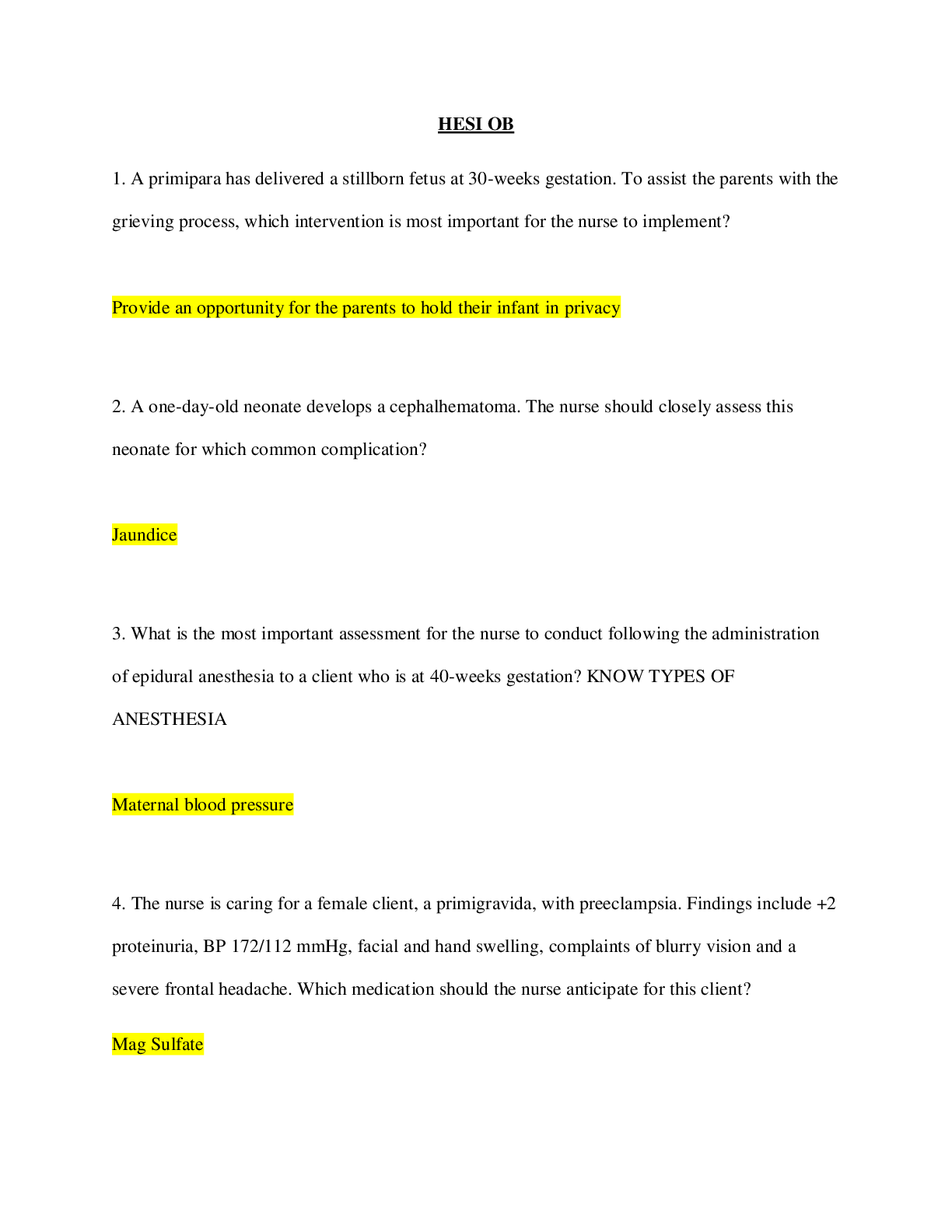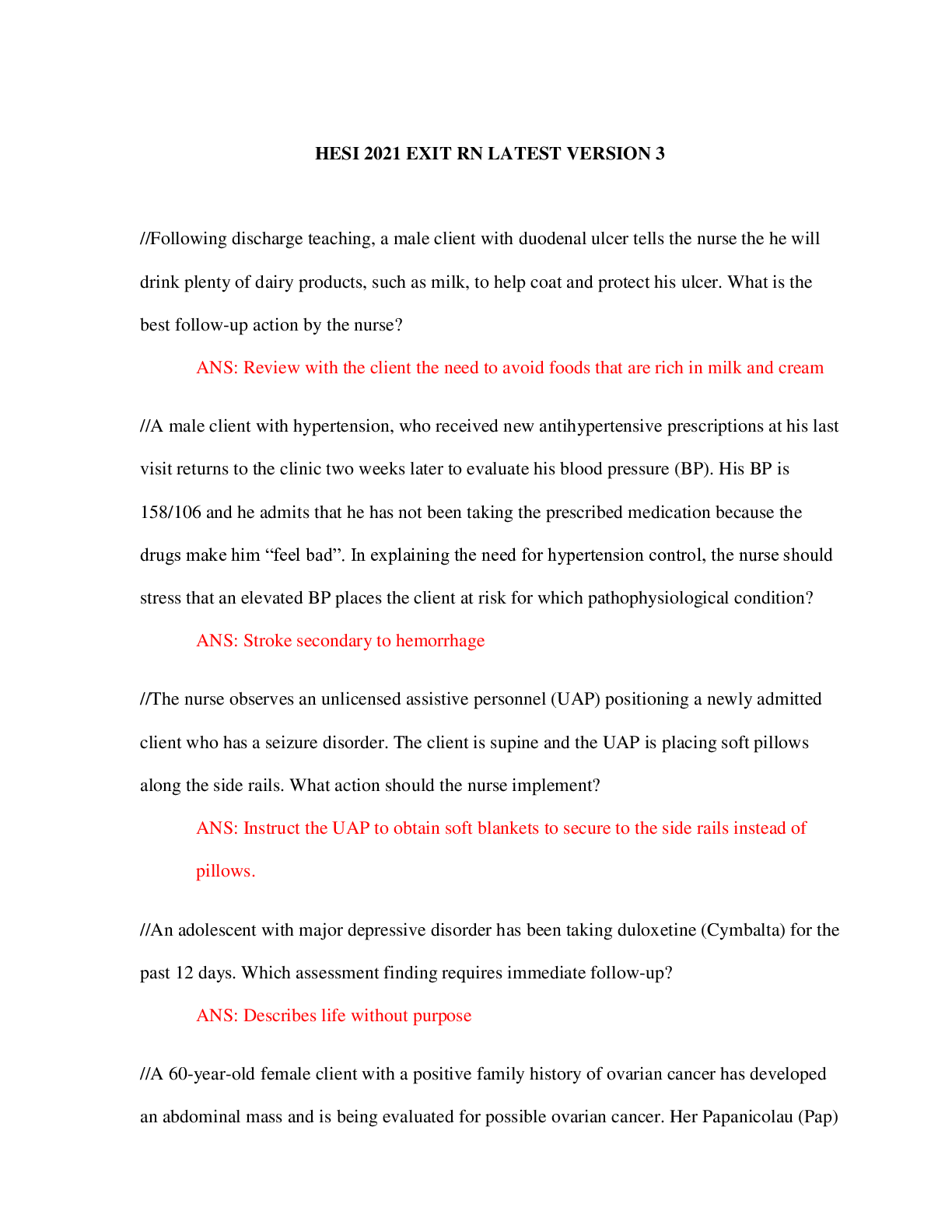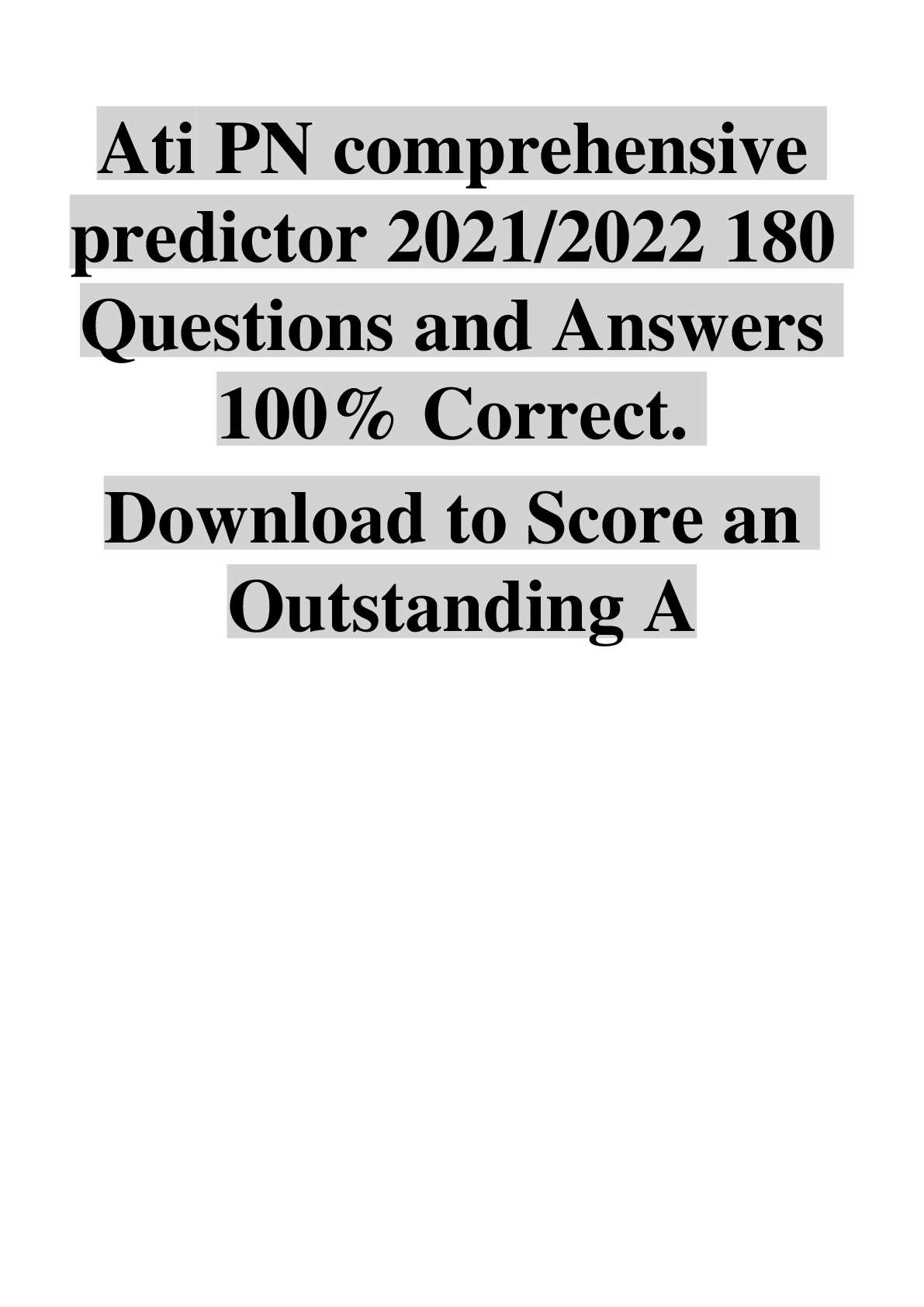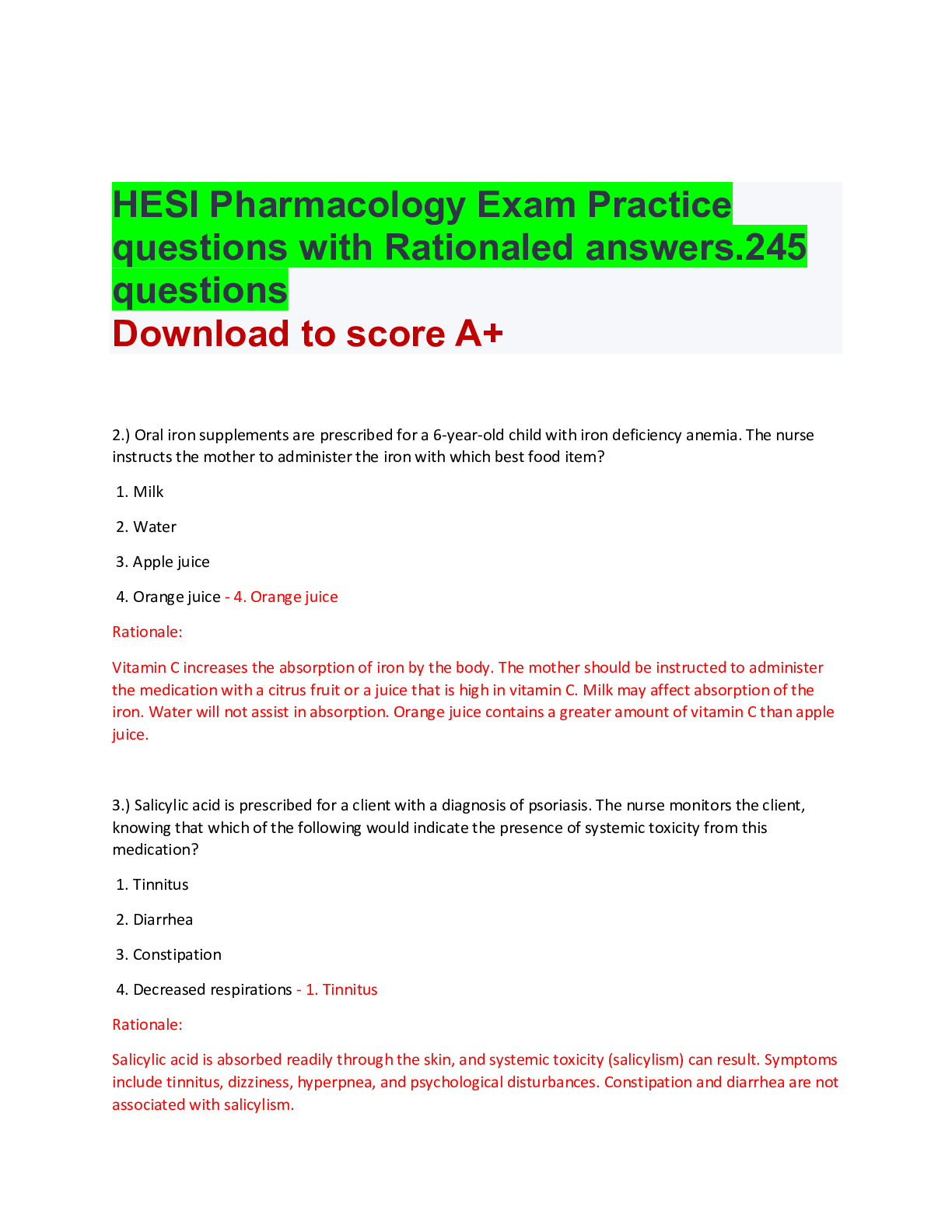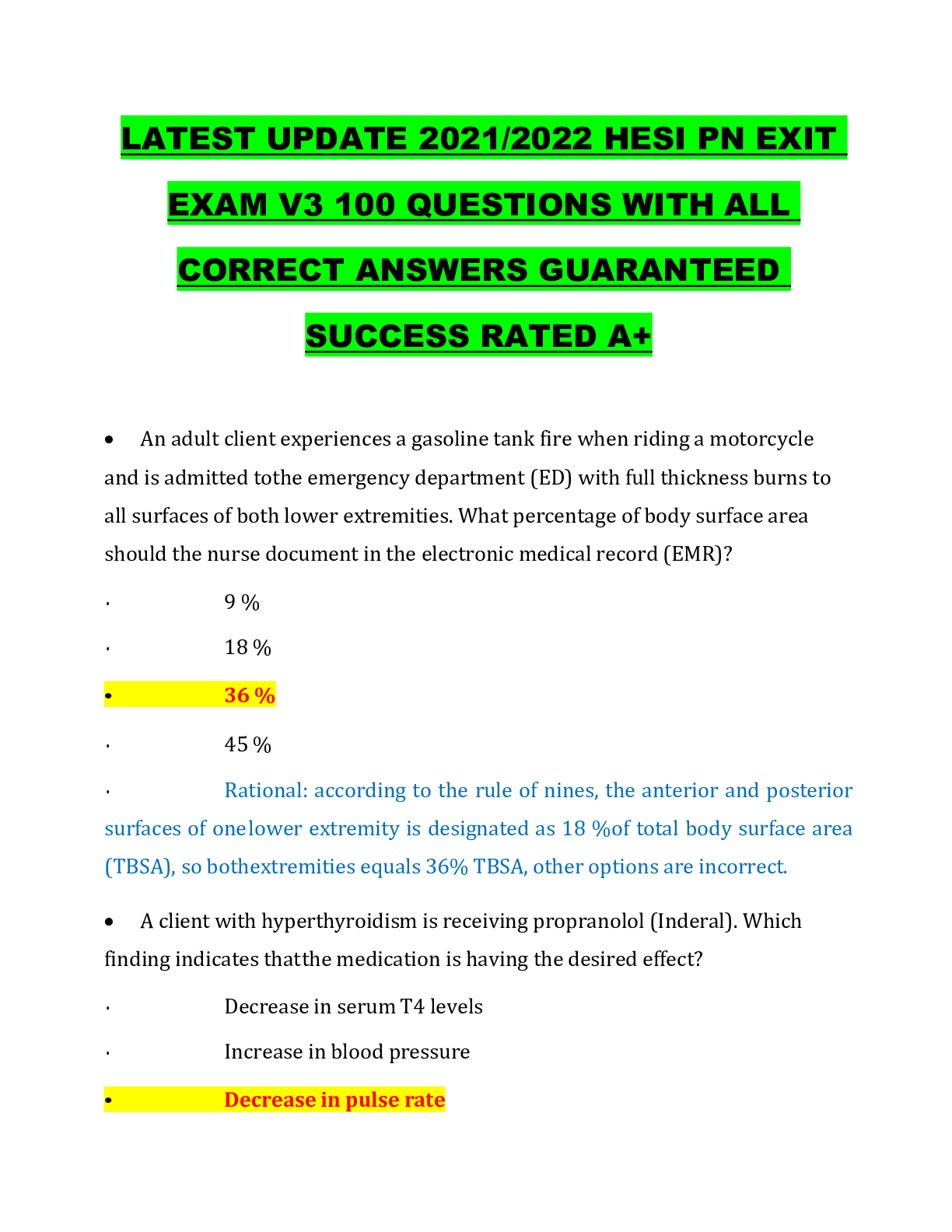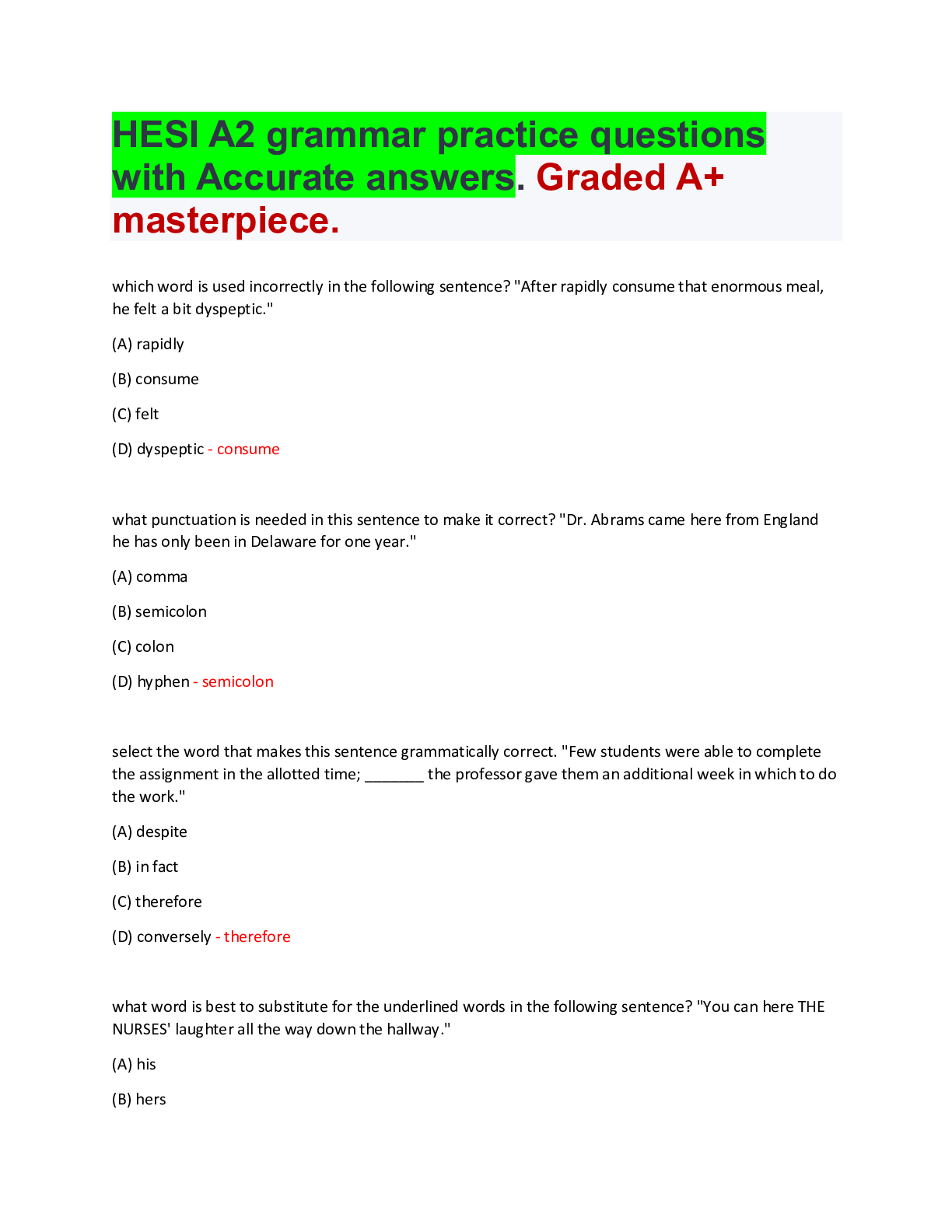*NURSING > HESI > Hesi Practice Exam (latest) 50 Questions With All Correct A Grade Answers | Download To Score A (All)
Hesi Practice Exam (latest) 50 Questions With All Correct A Grade Answers | Download To Score A
Document Content and Description Below
Hesi Practice Exam 1.An elderly client with a fractured left hip is on strict bedrest. Which nursing measure is essential to the client's nursing care? A. Massage any reddened areas for at least five ... minutes. B. Encourage active range of motion exercises on extremities. C. Position the client laterally, prone, and dorsally in sequence. D. Gently lift the client when moving into a desired position. 2. 2.ID: The nurse is administering medications through a nasogastric tube (NGT) which is connected to suction. After ensuring correct tube placement, what action should the nurse take next? A. Clamp the tube for 20 minutes. B. Flush the tube with water. C. Administer the medications as prescribed. D. Crush the tablets and dissolve in sterile water. 3. 3.ID: A client who is in hospice care complains of increasing amounts of pain. The healthcare provider prescribes an analgesic every four hours as needed. Which action should the nurse implement? A. Give an around-the-clock schedule for administration of analgesics. B. Administer analgesic medication as needed when the pain is severe. C. Provide medication to keep the client sedated and unaware of stimuli. D. Offer a medication-free period so that the client can do daily activities. 4. 4.ID: When assessing a client with wrist restraints, the nurse observes that the fingers on the right hand are blue. What action should the nurse implement first? A. Loosen the right wrist restraint. B. Apply a pulse oximeter to the right hand. C. Compare hand color bilaterally. D. Palpate the right radial pulse. 5. 5.ID: The nurse is assessing the nutritional status of several clients. Which client has the greatest nutritional need for additional intake of protein? A. A college-age track runner with a sprained ankle. B. A lactating woman nursing her 3-day-old infant. C. A school-aged child with Type 2 diabetes. D. An elderly man being treated for a peptic ulcer. 6. 6.ID: A client is in the radiology department at 0900 when the prescription levofloxacin (Levaquin) 500 mg IV q24h is scheduled to be administered. The client returns to the unit at 1300. What is the best intervention for the nurse to implement? A. Contact the healthcare provider and complete a medication variance form. B. Administer the Levaquin at 1300 and resume the 0900 schedule in the morning. C. Notify the charge nurse and complete an incident report to explain the missed dose. D. Give the missed dose at 1300 and change the schedule to administer daily at 1300. 7. 7.ID: While instructing a male client's wife in the performance of passive range-of-motion exercises to his contracted shoulder, the nurse observes that she is holding his arm above and below the elbow. What nursing action should the nurse implement? A. Acknowledge that she is supporting the arm correctly. B. Encourage her to keep the joint covered to maintain warmth. C. Reinforce the need to grip directly under the joint for better support. D. Instruct her to grip directly over the joint for better motion. 8. 8.ID: What is the most important reason for starting intravenous infusions in the upper extremities rather than the lower extremities of adults? A. It is more difficult to find a superficial vein in the feet and ankles. B. A decreased flow rate could result in the formation of a thrombosis. C. A cannulated extremity is more difficult to move when the leg or foot is used. D. Veins are located deep in the feet and ankles, resulting in a more painful procedure. 9. 9.ID: The nurse observes an unlicensed assistive personnel (UAP) taking a client's blood pressure with a cuff that is too small, but the blood pressure reading obtained is within the client's usual range. What action is most important for the nurse to implement? A. Tell the UAP to use a larger cuff at the next scheduled assessment. B. Reassess the client's blood pressure using a larger cuff. C. Have the unit educator review this procedure with the UAPs. D. Teach the UAP the correct technique for assessing blood pressure. 10. 10.ID: A client is receiving a secondary infusion of a 300 mg dose medication q6 hour. The preparation arrives from the pharmacy diluted in 50 mL of 0.9% Sodium Chloride (NaCl). The nurse plans to administer the dose over 20 minutes. For how many mL/hour should the nurse program the infusion pump to deliver the secondary infusion? (Enter the numeric value only.) 50/20=x/60 20x=3000 x=150 ml /hr 11. 11.ID: Twenty minutes after beginning a heat application, the client states that the heating pad no longer feels warm enough. What is the best response by the nurse? A. That means you have derived the maximum benefit, and the heat can be removed. B. Your blood vessels are becoming dilated and removing the heat from the site. C. We will increase the temperature 5 degrees when the pad no longer feels warm. D. The body's receptors adapt over time as they are exposed to heat. 12. 12.ID: The nurse is instructing a client with high cholesterol about diet and life style modification. What comment from the client indicates that the teaching has been effective? A. If I exercise at least two times weekly for one hour, I will lower my cholesterol. B. I need to avoid eating proteins, including red meat. C. I will limit my intake of beef to 4 ounces per week. D. My blood level of low density lipoproteins needs to increase. 13. 13.ID: The UAPs working on a chronic neuro unit ask the nurse to help them determine the safest way to transfer an elderly client with left-sided weakness from the bed to the chair. What method describes the correct transfer procedure for this client? A. Place the chair at a right angle to the bed on the client's left side before moving. B. Assist the client to a standing position, then place the right hand on the armrest. C. Have the client place the left foot next to the chair and pivot to the left before sitting. D. Move the chair parallel to the right side of the bed, and stand the client on the right foot. 14. 14.ID: An unlicensed assistive personnel (UAP) places a client in a left lateral position prior to administering a soap suds enema. Which instruction should the nurse provide the UAP? A. Position the client on the right side of the bed in reverse Trendelenburg. B. Fill the enema container with 1000 ml of warm water and 5 ml of castile soap. C. Reposition in a Sim's position with the client's weight on the anterior ilium. D. Raise the side rails on both sides of the bed and elevate the bed to waist level. 15. 15.ID: A client who is a Jehovah’s Witness is admitted to the nursing unit. Which concern should the nurse have for planning care in terms of the client’s beliefs? A. Autopsy of the body is prohibited. B. Blood transfusions are forbidden. C. Alcohol use in any form is not allowed. D. A vegetarian diet must be followed. 16. 16.ID: The nurse observes that a male client has removed the covering from an ice pack applied to his knee. What action should the nurse take first? A. Observe the appearance of the skin under the ice pack. B. Instruct the client regarding the need for the covering. C. Reapply the covering after filling with fresh ice. D. Ask the client how long the ice was applied to the skin. 17. 17.ID: The nurse mixes 50 mg of Nipride in 250 ml of D5W and plans to administer the solution at a rate of 5 mcg/kg/min to a client weighing 182 pounds. Using a drip factor of 60 gtt/ml, how many drops per minute should the client receive? A. 31 gtt/min. B. 62 gtt/min. C. 93 gtt/min. D. 124 gtt/min. is the correct calculation: Convert lbs to kg: 182/2.2 = 82.73 kg. Determine the dosage for this client: 5 mcg × 82.73 = 413.65 mcg/min. Determine how many mcg are contained in 1 ml: 250/50,000 mcg = 200 mcg per ml. The client is to receive 413.65 mcg/min, and there are 200 mcg/ml; so the client is to receive 2.07ml per minute. With a drip factor of 60 gtt/ml, then 60 × 2.07 = 124.28 gtt/min (D) OR, using dimensional analysis: gtt/min = 60 gtt/ml X 250 ml/50 mg X 1 mg/1,000 mcg X 5 mcg/kg/min X 1 kg/2.2 lbs X 182 lbs. 18. 18.ID: A hospitalized male client is receiving nasogastric tube feedings via a small-bore tube and a continuous pump infusion. He reports that he had a bad bout of severe coughing a few minutes ago, but feels fine now. What action is best for the nurse to take? A. Record the coughing incident. No further action is required at this time. B. Stop the feeding, explain to the family why it is being stopped, and notify the healthcare provider. C. After clearing the tube with 30 ml of air, check the pH of fluid withdrawn from the tube. D. Inject 30 ml of air into the tube while auscultating the epigastrium for gurgling. 19. 19.ID: A male client being discharged with a prescription for the bronchodilator theophylline tells the nurse that he understands he is to take three doses of the medication each day. Since, at the time of discharge, timed-release capsules are not available, which dosing schedule should the nurse advise the client to follow? A. 9 a.m., 1 p.m., and 5 p.m. B. 8 a.m., 4 p.m., and midnight. C. Before breakfast, before lunch and before dinner. D. With breakfast, with lunch, and with dinner. 20. 20.ID: A client is to receive 10 mEq of KCl diluted in 250 ml of normal saline over 4 hours. At what rate should the nurse set the client's intravenous infusion pump? A. 13 ml/hour. B. 63 ml/hour. 250/4 C. 80 ml/hour. D. 125 ml/hour. 21. 21.ID: An obese male client discusses with the nurse his plans to begin a long-term weight loss regimen. In addition to dietary changes, he plans to begin an intensive aerobic exercise program 3 to 4 times a week and to take stress management classes. After praising the client for his decision, which instruction is most important for the nurse to provide? A. Be sure to have a complete physical examination before beginning your planned exercise program. B. Be careful that the exercise program doesn't simply add to your stress level, making you want to eat more. C. Increased exercise helps to reduce stress, so you may not need to spend money on a stress management class. D. Make sure to monitor your weight loss regularly to provide a sense of accomplishment and motivation. 22. 22.ID: The nurse is teaching a client proper use of an inhaler. When should the client administer the inhaler-delivered medication to demonstrate correct use of the inhaler? A. Immediately after exhalation. B. During the inhalation. C. At the end of three inhalations. D. Immediately after inhalation. 23. 23.ID: The healthcare provider prescribes the diuretic metolazone (Zaroxolyn) 7.5 mg PO. Zaroxolyn is available in 5 mg tablets. How much should the nurse plan to administer? A. ½ tablet. B. 1 tablet. C. 1½ tablets. D. 2 tablets. 24. 24.ID: The healthcare provider prescribes furosemide (Lasix) 15 mg IV stat. On hand is Lasix 20 mg/2 ml. How many milliliters should the nurse administer? A. 1 ml. B. 1.5 ml. C. 1.75 ml. D. 2 ml. 25. 25.ID: Heparin 20,000 units in 500 ml D5W at 50 ml/hour has been infusing for 5½ hours. How much heparin has the client received? A. 11,000 units. B. 13,000 units. C. 15,000 units. D. 17,000 units. 26. 26.ID: The healthcare provider prescribes morphine sulfate 4mg IM STAT. Morphine comes in 8 mg per ml. How many ml should the nurse administer? A. 0.5 ml. B. 1 ml. C. 1.5 ml. D. 2 ml. 27. 27.ID: The nurse prepares a 1,000 ml IV of 5% dextrose and water to be infused over 8 hours. The infusion set delivers 10 drops per milliliter. The nurse should regulate the IV to administer approximately how many drops per minute? A. 80 B. 8 1000*10/8*60 C. 21 D. 25 28. 28.ID: Which action is most important for the nurse to implement when donning sterile gloves? A. Maintain thumb at a ninety degree angle. B. Hold hands with fingers down while gloving. C. Keep gloved hands above the elbows. D. Put the glove on the dominant hand first. 29. 29.ID: A client’s infusion of normal saline infiltrated earlier today, and approximately 500 ml of saline infused into the subcutaneous tissue. The client is now complaining of excruciating arm pain and demanding “stronger pain medications.” What initial action is most important for the nurse to take? A. Ask about any past history of drug abuse or addiction. B. Measure the pulse volume and capillary refill distal to the infiltration. C. Compress the infiltrated tissue to measure the degree of edema. D. Evaluate the extent of ecchymosis over the forearm area. 30. 30.ID: An elderly male client who is unresponsive following a cerebral vascular accident (CVA) is receiving bolus enteral feedings though a gastrostomy tube. What is the best client position for administration of the bolus tube feedings? A. Prone. B. Fowler's. C. Sims'. D. Supine. 31. 31.ID: A 73-year-old female client had a hemiarthroplasty of the left hip yesterday due to a fracture resulting from a fall. In reviewing hip precautions with the client, which instruction should the nurse include in this client's teaching plan? A. In 8 weeks you will be able to bend at the waist to reach items on the floor. B. Place a pillow between your knees while lying in bed to prevent hip dislocation. C. It is safe to use a walker to get out of bed, but you need assistance when walking. D. Take pain medication 30 minutes after your physical therapy sessions. 32. 32.ID: A client with pneumonia has a decrease in oxygen saturation from 94% to 88% while ambulating. Based on these findings, which intervention should the nurse implement first? A. Assist the ambulating client back to the bed. B. Encourage the client to ambulate to resolve pneumonia. C. Obtain a prescription for portable oxygen while ambulating. D. Move the oximetry probe from the finger to the earlobe. 33. 33.ID: A client with chronic renal failure selects a scrambled egg for his breakfast. What action should the nurse take? A. Commend the client for selecting a high biologic value protein. B. Remind the client that protein in the diet should be avoided. C. Suggest that the client also select orange juice, to promote absorption. D. Encourage the client to attend classes on dietary management of CRF. 34. 34.ID: A client who is 5' 5" tall and weighs 200 pounds is scheduled for surgery the next day. What question is most important for the nurse to include during the preoperative assessment? A. What is your daily calorie consumption? B. What vitamin and mineral supplements do you take? C. Do you feel that you are overweight? D. Will a clear liquid diet be okay after surgery? 35. 35.ID: During the initial morning assessment, a male client denies dysuria but reports that his urine appears dark amber. Which intervention should the nurse implement? A. Provide additional coffee on the client's breakfast tray. B. Exchange the client's grape juice for cranberry juice. C. Bring the client additional fruit at mid-morning. D. Encourage additional oral intake of juices and water. 36. 36.ID: Which intervention is most important for the nurse to implement for a male client who is experiencing urinary retention? A. Apply a condom catheter. B. Apply a skin protectant. C. Encourage increased fluid intake. D. Assess for bladder distention. 37. 37.ID: A client with acute hemorrhagic anemia is to receive four units of packed RBCs (red blood cells) as rapidly as possible. Which intervention is most important for the nurse to implement? A. Obtain the pre-transfusion hemoglobin level. B. Prime the tubing and prepare a blood pump set-up. C. Monitor vital signs q15 minutes for the first hour. D. Ensure the accuracy of the blood type match. 38. 38.ID: Which snack food is best for the nurse to provide a client with myasthenia gravis who is at risk for altered nutritional status? A. Chocolate pudding. B. Graham crackers. C. Sugar free gelatin. D. Apple slices. 39. 39.ID: The nurse is evaluating client learning about a low-sodium diet. Selection of which meal would indicate to the nurse that this client understands the dietary restrictions? A. Tossed salad, low-sodium dressing, bacon and tomato sandwich. B. New England clam chowder, no-salt crackers, fresh fruit salad. C. Skim milk, turkey salad, roll, and vanilla ice cream. D. Macaroni and cheese, diet Coke, a slice of cherry pie. 40. 40.ID: Which nutritional assessment data should the nurse collect to best reflect total muscle mass in an adolescent? A. Height in inches or centimeters. B. Weight in kilograms or pounds. C. Triceps skin fold thickness. D. Upper arm circumference. 41. 41.ID: An elderly resident of a long-term care facility is no longer able to perform self-care and is becoming progressively weaker. The resident previously requested that no resuscitative efforts be performed, and the family requests hospice care. What action should the nurse implement first? A. Reaffirm the client's desire for no resuscitative efforts. B. Transfer the client to a hospice inpatient facility. C. Prepare the family for the client's impending death. D. Notify the healthcare provider of the family's request. 42. 42.ID: After completing an assessment and determining that a client has a problem, which action should the nurse perform next? A. Determine the etiology of the problem. B. Prioritize nursing care interventions. C. Plan appropriate interventions. D. Collaborate with the client to set goals. 43. 43.ID: An elderly client who requires frequent monitoring fell and fractured a hip. Which nurse is at greatest risk for a malpractice judgment? A. A nurse who worked the 7 to 3 shift at the hospital and wrote poor nursing notes. B. The nurse assigned to care for the client who was at lunch at the time of the fall. C. The nurse who transferred the client to the chair when the fall occurred. D. The charge nurse who completed rounds 30 minutes before the fall occurred. 44. 44.ID: A postoperative client will need to perform daily dressing changes after discharge. Which outcome statement best demonstrates the client's readiness to manage his wound care after discharge? The client A. asks relevant questions regarding the dressing change. B. states he will be able to complete the wound care regimen. C. demonstrates the wound care procedure correctly. D. has all the necessary supplies for wound care. 45. 45.ID: When evaluating a client's plan of care, the nurse determines that a desired outcome was not achieved. Which action will the nurse implement first? A. Establish a new nursing diagnosis. B. Note which actions were not implemented. C. Add additional nursing orders to the plan. D. Collaborate with the healthcare provider to make changes. 46. 46.ID: The healthcare provider prescribes 1,000 ml of Ringer's Lactate with 30 Units of Pitocin to run in over 4 hours for a client who has just delivered a 10 pound infant by cesarean section. The tubing has been changed to a 20 gtt/ml administration set. The nurse plans to set the flow rate at how many gtt/min? A. 42 gtt/min. B. 83 gtt/min. C. 125 gtt/min. D. 250 gtt/min. 47. 47.ID: Seconal 0.1 gram PRN at bedtime is prescribed to a client for rest. The scored tablets are labeled grain 1.5 per tablet. How many tablets should the nurse plan to administer? A. 0.5 tablet. B. 1 tablet. C. 1.5 tablets. D. 2 tablets. 48. 48.ID: Which assessment data would provide the most accurate determination of proper placement of a nasogastric tube? A. Aspirating gastric contents to assure a pH value of 4 or less. B. Hearing air pass in the stomach after injecting air into the tubing. C. Examining a chest x-ray obtained after the tubing was inserted. D. Checking the remaining length of tubing to ensure that the correct length was inserted. 49. 49.ID: The nurse is caring for a client who is receiving 24-hour total parenteral nutrition (TPN) via a central line at 54 ml/hr. When initially assessing the client, the nurse notes that the TPN solution has run out and the next TPN solution is not available. What immediate action should the nurse take? A. Infuse normal saline at a keep vein open rate. B. Discontinue the IV and flush the port with heparin. C. Infuse 10 percent dextrose and water at 54 ml/hr. D. Obtain a stat blood glucose level and notify the healthcare provider. 50. 50.ID: When assisting an 82-year-old client to ambulate, it is important for the nurse to realize that the center of gravity for an elderly person is the A. Arms. B. Upper torso. C. Head. D. Feet. [Show More]
Last updated: 1 year ago
Preview 1 out of 26 pages

Reviews( 0 )
Document information
Connected school, study & course
About the document
Uploaded On
Aug 11, 2021
Number of pages
26
Written in
Additional information
This document has been written for:
Uploaded
Aug 11, 2021
Downloads
0
Views
57



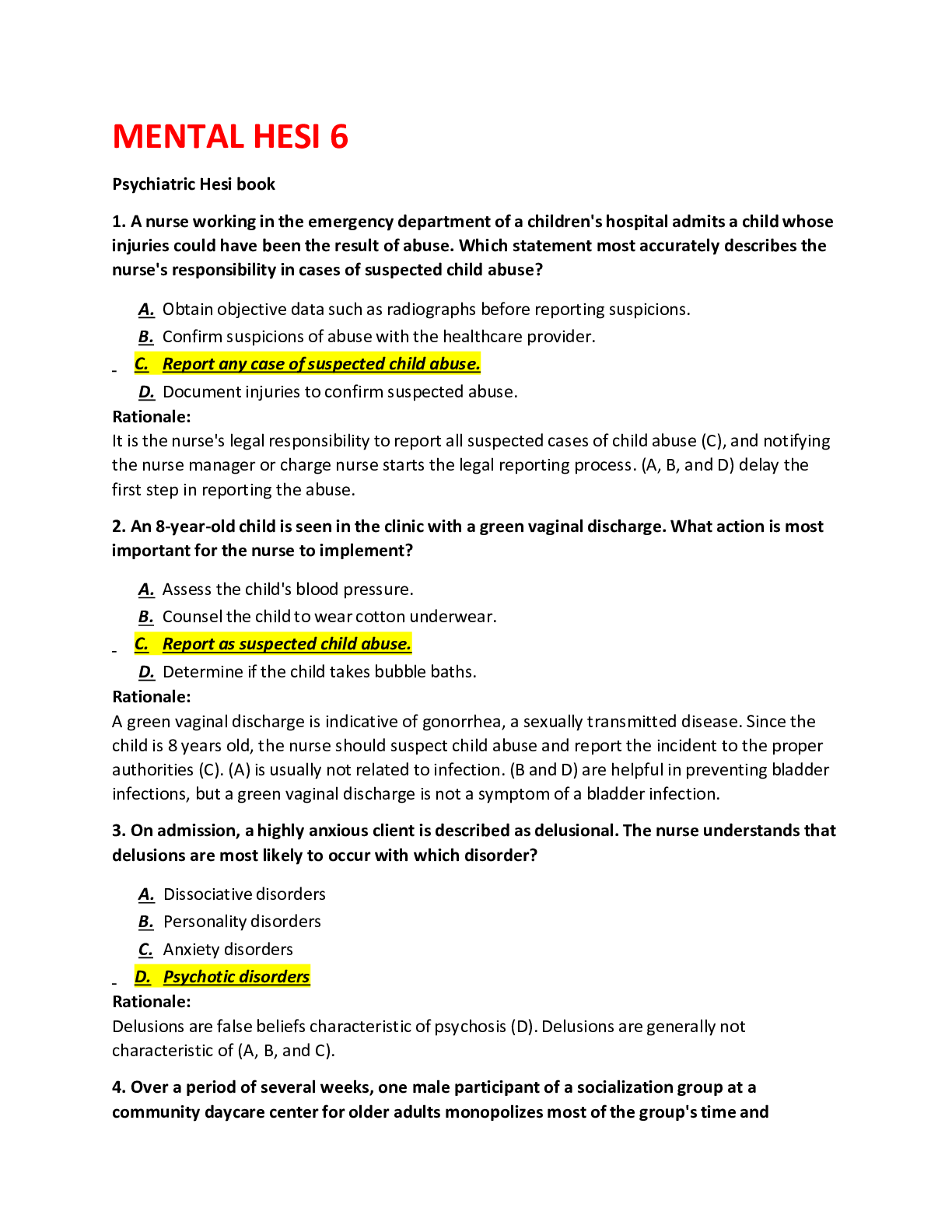
.png)


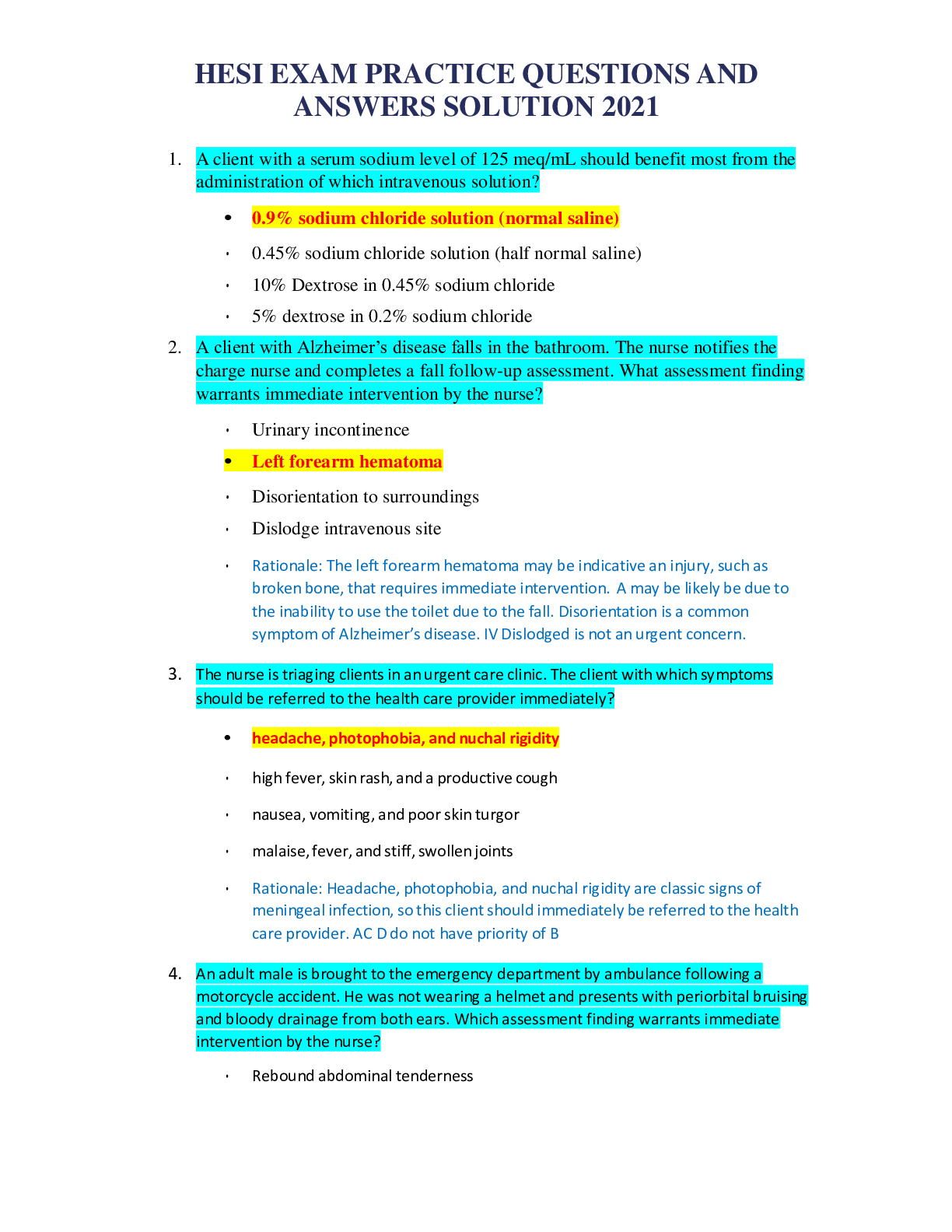
.png)
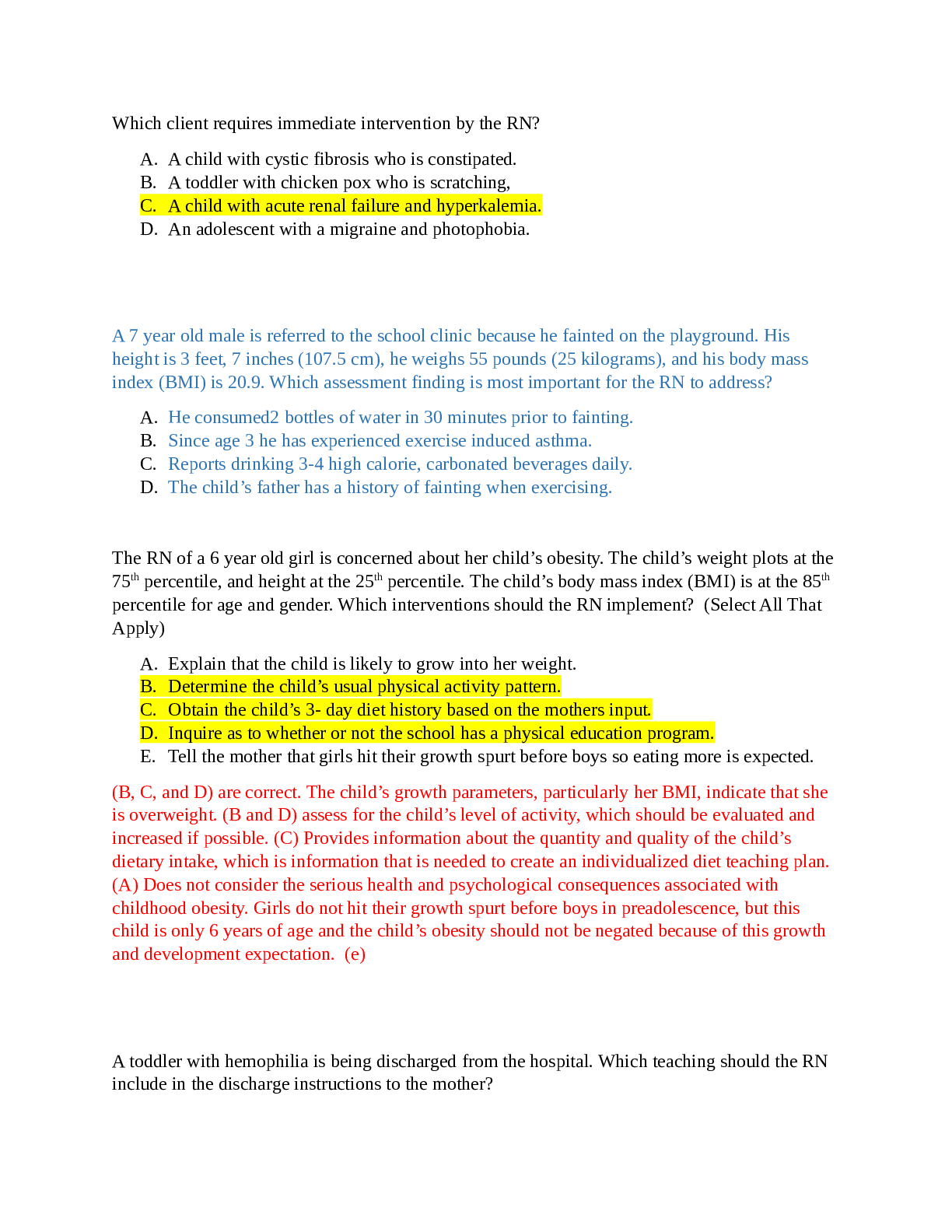



.png)
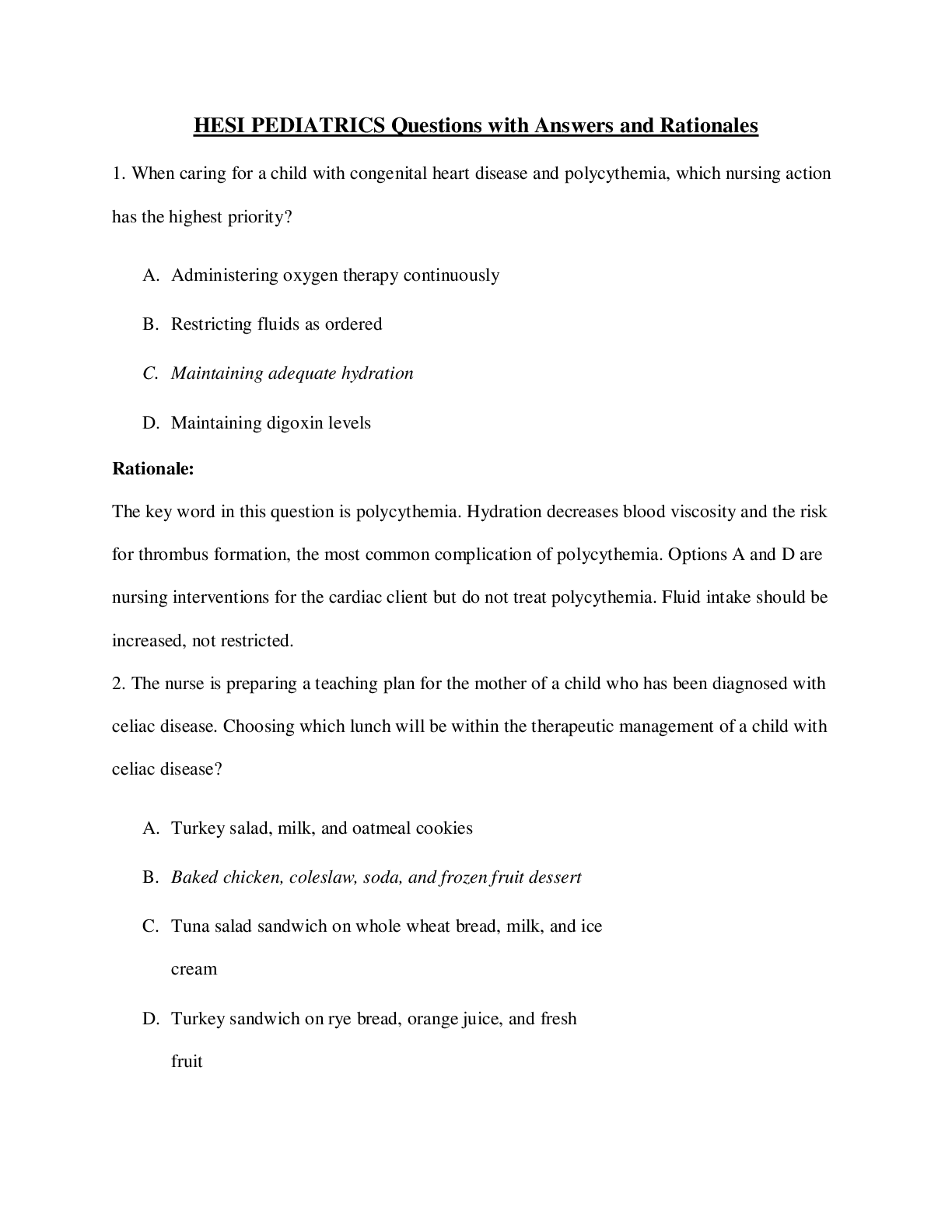
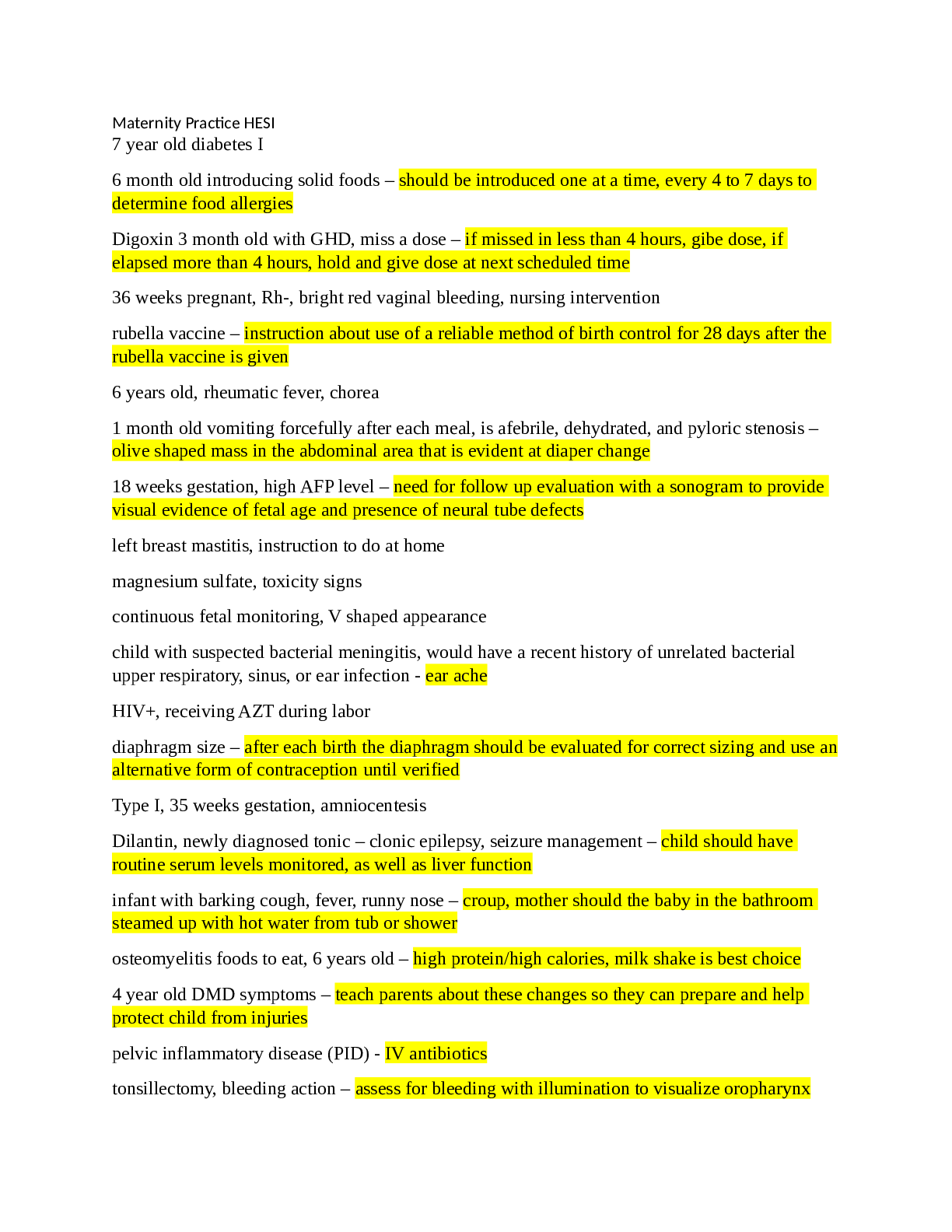

 - Over 500 Questions (Latest 2021) Correct Study Guide, Download to Score A.png)
, Latest Questions and Answers with Explanations, All Correct Study Guide, Download to Score A.png)
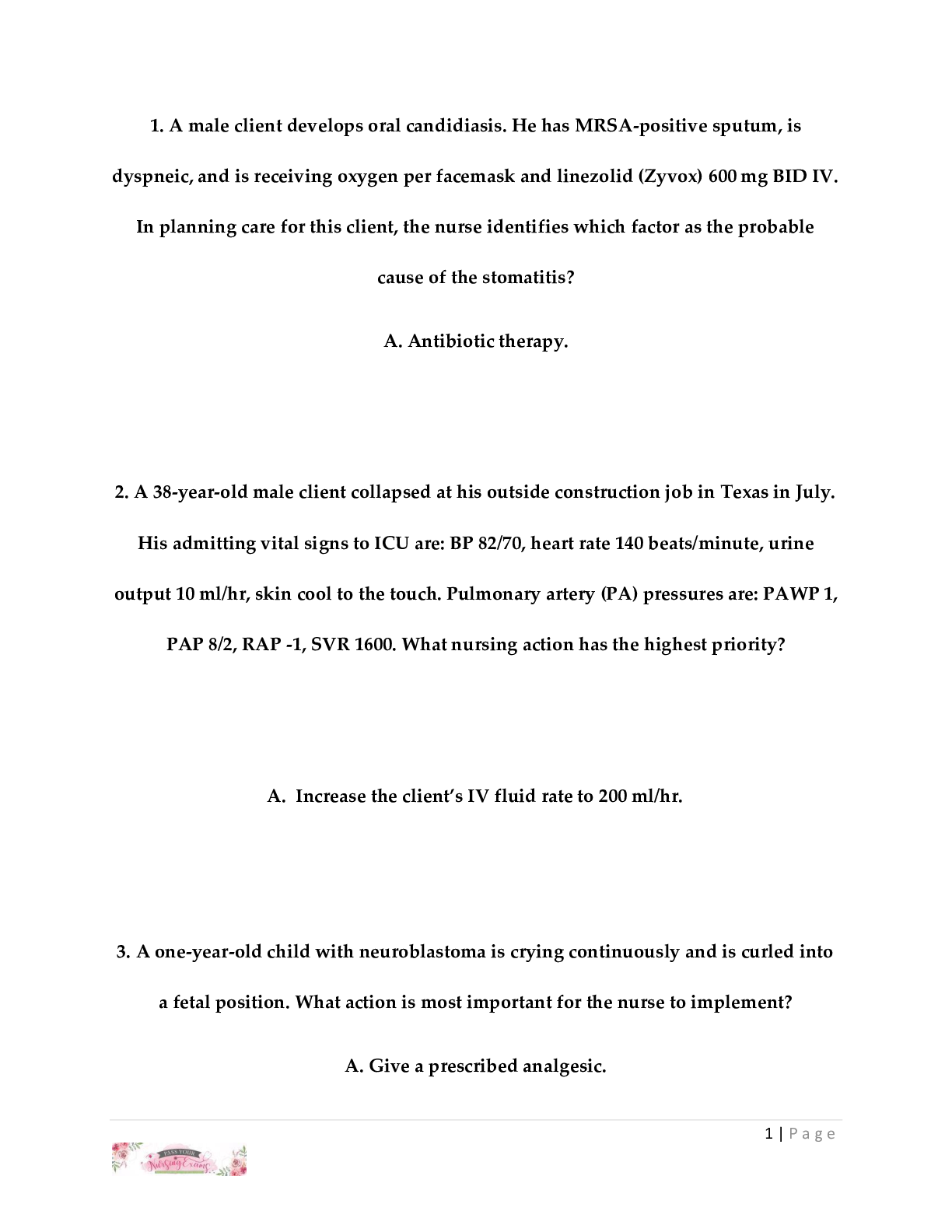

 Correct Study Guide, Download to Score A.png)
